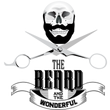PETROLATUM IN BEARD & MUSTACHE PRODUCTS
One of the key elements in our moustache wax is petrolatum (or petroleum jelly/Mineral Oil), though much like band-aids or kleenex, it is a product more commonly known by its most recognizable brand name, Vaseline. There is some controversy about this ingredient and it has an interesting history, so lets take a closer look.

The History of Petrolatum
The origins of petroleum date back to 1859, in the ironically-named small town of Titusville in Pennsylvania, USA, where workers on some of America's first-ever oil rigs noticed a black paraffin-type substance (similar to what a crayon is made from) forming on the railings, which they called 'rod wax'. Though it interfered with the smooth operation of the rig, it was discovered by the workers that the material had a knack for helping heal some of the burns and cuts suffered during their work.
A few years later, an aspiring chemist called Robert Chesebrough, who had lost his previous work of fuel distillation from sperm whale oil due to the emergence of these petroleum rigs, came to Titusville to see if there were any materials he could use in creating a potential commercial product not yet covered by the market.
This led him to discover the rod wax, with which he experimented on the raw samples and found that through vacuum distillation of the oil products, he could create a light gel by filtering the result through bone char.
Following that, Chesebrough toured the state of New York offering demonstrations of his new 'miracle healing ointment' showing dedication to the cause by burning himself with an open flame and using his mixture to demonstrate the healing effect.
By 1870, he had enough momentum to begin mass-producing, opening a factory in Brooklyn to sell his product under the name 'Vaseline Petroleum Jelly'. After a while to settle into the market, it developed into a best-seller around the world, and inspired a range of similar compounds used in the cosmetics industry, some to this day.
Though Chesebrough's own method is now a little dated, his principles of producing petrolatum through distillation and filteration are the core elements of the methods used today.
Also known as soft paraffin, paraffin jelly, or mineral jelly, the name vaseline tended to be the one that stuck (pun intended), and while it led to plenty of defenses of a trademark by the Chesebrough Manufacturing Company, they have managed a rare feat of having their brand name being pretty much synonymous with the product itself.
When marketing his invention, Chesebrough claimed that Vaseline could be used not only for medical purposes, but also for general lubrication, leather treatment, treatment for chapped hands, and most significantly in this instance, as a hair pomade.
While most of those purposes remain to this day, and use of petrolatum jelly has also diversified to find use in food production, manufacturing, electrical insulation, tattoo preparation, and general product longevity/cleaning (among other things), at The Beard & The Wonderful we're more focused on what happens when you mix it with beeswax, giving the balance of texture needed to create our world famous moustache wax.
Is vaseline good for beard and moustache?
Is petrolatum safe on skin?
Our wax is designed to be used on hair rather than skin, but we still take our responsibilities very seriously. Although unrefined petrolatum does have some health concerns, properly refined petroleum jelly has no known health concerns.
Although there are alternatives to petrolatum, in our experience nothing works as well, so we only use fully refined white petrolatum, and the finest beeswax blended to perfection in our Portland's finest mustache wax.


Hi Guys!
Great story about Petrolatum. I do hope you are using our Vaseline! :).
Greetings from Amsterdam,
Jason
Sonneborn Refined Products
Leave a comment